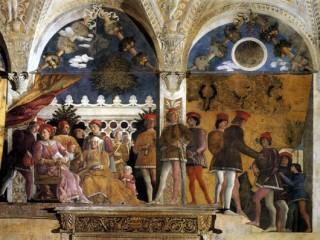
Andrea Mantegna biography
Date of birth : -
Date of death : -
Birthplace : Isola di Carturo, Italy
Nationality : Italian
Category : Arts and Entertainment
Last modified : 2010-11-29
Credited as : Artist painter, engraver, artist of the school of Padua
Andrea Mantegna (ca. 1430-1506), painter and engraver, was the leading artist of the school of Padua and one of the most important early Renaissance Italian masters.
Andrea Mantegna, the son of the carpenter Biagio, was born at Isola di Carturo about halfway between Padua and Vicenza. The inscription on a lost altarpiece he executed (the inscription was preserved in written records) in 1447 states that the artist was 17. His name appeared on the painters' roll for Padua between 1441 and 1445 as an apprentice and adopted son of Francesco Squarcione. It was not unusual for childless masters to adopt promising apprentices. In 1448 Mantegna left Squarcione's household and established himself as an independent artist.
Seven years later Mantegna went to court to dissolve their relationship. He declared that he had earned more than 400 ducats for Squarcione and sued for reimbursement of the money. Squarcione contested Mantegna's suit, citing an agreement they had signed in 1448 in Venice. The court awarded Mantegna 200 ducats and denounced the 1448 agreement. These accounts suggest that Mantegna was responsible for a substantial number of paintings while serving in Squarcione's studio and, furthermore, that his efforts were generally well known.
In 1448 Mantegna, Giovanni d'Alemagna, Antonio Vivarini, and Niccolo Pizzolo were commissioned to fresco the Ovetari Chapel in the Church of the Eremitani, Padua, with the stories of St. James and St. Christopher. The initial contract divided the work more or less equally among the four artists, but, owing to subsequent disputes and the deaths of Giovanni d'Alemagna and Pizzolo, Mantegna painted the greater part of the frescoes. An appraisal of the work was carried out in 1454, which confirmed that the other three artists had only partially finished their assignments. Mantegna completed the project in 1455. There are numerous references to his difficult personality. It seems that he was a proud and abrasive person who did not get along well with others.
The Ovetari Chapel frescoes, Mantegna's early masterpiece, were almost totally destroyed during World War II. They showed Mantegna's concern for establishing rather crisp, sculpturesque forms in an accurately rendered perspective space which carefully took into account the beholder's viewpoint. Also, details of costume, armor, and architecture demonstrated that Mantegna had an archeological interest in classical antiquity.
In 1453 Mantegna married Niccolosa Bellini, the daughter of the Venetian painter Jacopo Bellini. The marriage brought Mantegna into an important artistic family.
Mantegna painted a number of important works during his Paduan period (1448-1460), including the St. Luke Altarpiece (Milan), St. Sebastian (Vienna), Agony in the Garden (London), the portraits of Cardinal Mezzarota (Berlin) and Cardinal Francesco Gonzaga (Naples), and the altarpiece for the church of S. Zeno in Verona. The S. Zeno Altarpiece was inspired by Donatello's high altar for the church of S. Antonio in Padua and combined real and painted elements in a unified way that anticipated Mantegna's paintings in the Camera degli Sposi in Mantua.
In 1459 Mantegna was appointed court painter to Ludovico Gonzaga in Mantua, and the following year the artist moved there from Padua. The Camera degli Sposi in the Ducal Palace was completed in 1474. It is not known for certain when Mantegna began the project. In 1466-1467 he visited Florence and Pisa. Stylistic aspects of the frescoes suggest that Mantegna did not begin them until he returned from Florence. It is known by a letter that the artist was working on the project in October 1471.
The Camera degli Sposi is a rectangular room with a moved barrel vault broken by three lunettes on each wall. Mantegna transformed the ceiling into a painted dome with an oculus in the center through which we catch a glimpse of a cloud-flecked sky and see the faces of people and cherubs looking down into the chamber. The walls are painted to resemble a landscape seen through openings in an airy pavilion. On one wall is the return of Cardinal Francesco Gonzaga; on another wall is a portrait of the Gonzaga family posed on a platform that seems to rest on the real mantle of the fireplace. In his decorations Mantegna unified the actual space of the room with the painted space of the frescoes to create an illusionism that foretells the work of Correggio.
Mantegna's artistic output was of remarkably high quality. In 1484 he began the series of nine canvases of the Triumph of Caesar (Hampton Court) for Francesco II Gonzaga, which was not finished before 1492. Lorenzo the Magnificent, the ruler of Florence, called on Mantegna in his studio in Mantua in 1484. Between 1488 and 1490 Mantegna was in Rome working for Pope Innocent VIII. His Madonna della Vittoria (Paris) of 1496 commemorates the battle of Fornovo of the preceding year. Other important works of the 1490s include the Dead Christ (Milan) and St. Sebastian (Venice). In the 1500s he painted two canvases for the studiolo of Isabella d'Este: Parnassus and Minerva Expelling the Vices from the Garden of Virtue (both Paris).
A number of engravings are attributed to Mantegna. Whether he engraved the plates himself or—and this seems more plausible—made the designs which were then engraved by other craftsmen is not known. The so-called autograph engravings include the Entombment, Risen Christ between Saints Andrew and Longinus, Madonna and Child, Battle of the Sea Gods, Bacchanal with Silenus, and Bacchanal with a Vat. Mantegna died on Sept. 13, 1506, in Mantua.
A sound monograph on Mantegna is E. Tietze-Conrat, Mantegna: Paintings, Drawings and Engravings (1955). Paul Kristeller, Andrea Mantegna (1901), is still useful. See also Millard Meiss, Andrea Mantegna as Illuminator (1957).
















